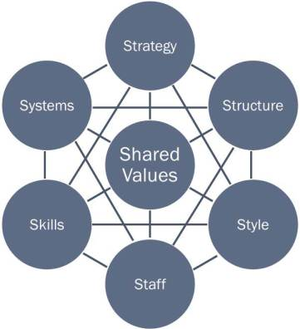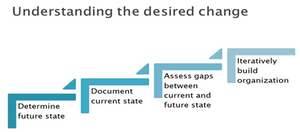McKinsey 7S Framework
Developed in the early 1980s by Tom Peters and Robert Waterman of McKinsey & Company, is a management model (7S Framework), the basic premise of which is that there are seven internal aspects of an organization that need to be aligned for it to be successful.
The 7S Model can be used in a wide variety of situations where an alignment perspective is useful, for example, to help you:
- Improve the performance of a company.
- Examine the likely effects of future changes within a company.
- Align departments and processes during a merger or acquisition.
- Determine how best to implement a proposed strategy. [1]
Elements of The 7S Model
The basic premise of the model is that there are seven internal aspects of an organization that need to be aligned if it is to be successful The Elements are split into two groups - Hard and Soft
- Hard Elements
- Strategy - Purpose of the business and the way the organization seeks to enhance its competitive advantage.
- Structure - Division of activities; integration and coordination mechanisms.
- Systems - Formal procedures for measurement, reward and resource allocation.
- Soft Elements
- Shared Values
- Skills - The organization's core competencies and distinctive capabilities.
- Staff - Organization's human resources, demographic, educational and attitudinal characteristics.
- Style - Typical behaviour patterns of key groups, such as managers, and other professionals.

Source: Educational Business Articles
There is no hierarchy in terms of importance of these interrelated elements suggesting that any significance progress with one would not be possible without working on the others.

Source: The Organizational Strategist
Applying McKinsey 7S Model Assessments
With planned change, the destination or future state should be understood first. This knowledge gives perspective. Having a future state vision allows one to gauge progress, set targets, and milestones to achieve. Once the future state is known, the current state can be documented to show a comparison. This makes it clear what can be leveraged, where the current strengths are, and where there are areas to build or holes to fill. The gap analysis leads to steps to build upon.[2]

Source: Seattle Pi
In order to most effectively change an organization, the foundational characteristics (Shared Values) and broad ranging direction (Strategy) should be addressed first. Following that, the internal coordination (Structure) and setup (System) should be determined to align to the direction. Lastly, the more people-centric areas fulfill an organization’s goals and objectives. That is done via updates to its capability (Skills), individual placement (Staff) and the manners that people interact and work (Style).

Source: Seattle Pi
The McKinsey 7S Model is helpful in delivering a comprehensive organizational analysis. Using that information can lead to a new vision, through internal operation updates, and down to individual abilities and placement. Mapping out change in its entirety is very helpful in its planning. The successful execution and management of that change then requires a comprehensive, dedicated, business impact-focused, and sustained effort.
References
Further Reading
Enduring Ideas: The 7-S Framework McKinsey&Company
CIO Desk Reference
(Relevant content on this topic in the CIO Toolkit on CIO Index)
- IT Strategy: Organisational Capability Analysis Frameworks CIO Index
